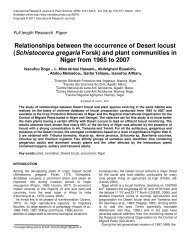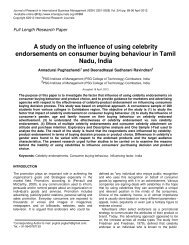Antibacterial and antifungal activities of Cestrum parqui saponins ...
Antibacterial and antifungal activities of Cestrum parqui saponins ...
Antibacterial and antifungal activities of Cestrum parqui saponins ...
Create successful ePaper yourself
Turn your PDF publications into a flip-book with our unique Google optimized e-Paper software.
002 Int. Res. J. Plant Sci.<br />
generating pores formation <strong>and</strong> consequently, loss <strong>of</strong> cell<br />
integrity. Furthermore, these <strong>saponins</strong> with alcaloidic<br />
aglycone can not only bind to sterol but also<br />
straightforwardly extract it from the membrane (Morrissey<br />
<strong>and</strong> Osbourn, 1999). The mechanism <strong>of</strong> action <strong>of</strong><br />
<strong>saponins</strong> has been elucidated against Fusarium solani<br />
where mutant strains defective out <strong>of</strong> membrane sterols<br />
are able to infect the green fruits <strong>of</strong> tomato rich in αtomatine<br />
(a steroidic saponin) (Morrissey <strong>and</strong> Osbourn,<br />
1999; Papadopoulou et al., 1999 ). Many research works<br />
have showed that the activity <strong>of</strong> <strong>saponins</strong> is more related<br />
to their sugar chain <strong>and</strong> thus, any modification <strong>of</strong> this<br />
chain can provoke modification <strong>of</strong> the biological activity <strong>of</strong><br />
the entire molecule. Consequently, fungi can resist to<br />
plant <strong>saponins</strong> by the partial or the total degradation <strong>of</strong><br />
sugar chains thanks to their enzymatic arsenal (Bourab et<br />
al., 2002; Barile et al., 2007; Tsuzuki et al. 2007; Stuardo<br />
<strong>and</strong> San Martyn, 2008; Yadava <strong>and</strong> Chakravarti, 2009).<br />
The <strong>antifungal</strong> activity constitutes an interesting<br />
property for the assessment <strong>of</strong> saponin’s activity <strong>and</strong><br />
quantity in plants. Moreover, the <strong>antifungal</strong> tests are<br />
relatively precise <strong>and</strong> simpler than chromatographic <strong>and</strong><br />
spectroscopic techniques. In fact, some in vitro tests are<br />
conducted by using fungal species belonging to<br />
Trichoderma genus because they are particularly<br />
sensitive to <strong>saponins</strong> (Jurzysta, 1986).<br />
Cells <strong>of</strong> the prokaryotes such as bacteria do not<br />
contain membrane sterols suggesting that these<br />
organisms are not sensitive to this type <strong>of</strong> molecules as<br />
reported by several authors (Morrissey <strong>and</strong> Osbourn,<br />
1999). Sprag et al. (2004) pointed that <strong>saponins</strong> did not<br />
inhibit microbial growth <strong>of</strong> dense populations.<br />
In this work, the antibacterial <strong>and</strong> <strong>antifungal</strong> activity <strong>of</strong><br />
the crude saponic extract (CSE) <strong>of</strong> a local ecotype <strong>of</strong><br />
<strong>Cestrum</strong> <strong>parqui</strong> was evaluated against several bacterial<br />
<strong>and</strong> fungal agents <strong>and</strong> the interaction <strong>of</strong> <strong>saponins</strong> <strong>and</strong><br />
membrane sterols was studied in relation with their<br />
eventual biological <strong>activities</strong>.<br />
MATERIALS AND METHODS<br />
Bacterial agents<br />
Four bacterial reference strains were tested: two Grampositive<br />
(Pseudomonas aeruginosa <strong>and</strong> Escherchia coli)<br />
<strong>and</strong> two Gram-negative (Staphylococcus aureus <strong>and</strong><br />
Enterococcus faecalis). Bacterial strains were gratefully<br />
provided by the Faculty <strong>of</strong> Pharmacy <strong>of</strong> Monastir, Tunisia.<br />
They were cultivated at 37°C in Luria broth (LB) medium<br />
at 200 rpm in rotary shaker. For their long term<br />
preservation, cultures were maintained at -20°C in LB<br />
medium supplemented with 15% glycerol.<br />
Fungal agents<br />
Fusarium solani was isolated from potato tubers showing<br />
typical symptoms <strong>of</strong> dry rot <strong>and</strong> Botrytis cinerea was<br />
obtained from tomato fruits exhibiting gray mold signs.<br />
Trichoderma viride was gratefully provided by the<br />
Laboratory <strong>of</strong> Phytopathology <strong>of</strong> The Regional Center <strong>of</strong><br />
Research in Horticulture <strong>and</strong> Organic Agriculture,<br />
Tunisia.<br />
All fungal agents were cultured on potato dextrose agar<br />
(PDA) medium supplemented with 300 mg/l <strong>of</strong><br />
streptomycin sulphate <strong>and</strong> incubated for one week at<br />
23°C before use. For their preservation, up to 12 months,<br />
monoconidial cultures were maintained at -20°C in a 20%<br />
glycerol solution.<br />
Extraction <strong>of</strong> <strong>saponins</strong><br />
Saponin extraction was performed according to Chaieb et<br />
al. (2007). The leaves <strong>of</strong> C. <strong>parqui</strong> were obtained from<br />
the garden <strong>of</strong> the National Tunisian Agronomic Institute,<br />
Tunisia. They were dried in a steamroom at 40°C for 4<br />
days <strong>and</strong> the dried leaves were finely grounded. One<br />
hundred grams (100 g) <strong>of</strong> the obtained leaf powder was<br />
washed with petrol ether <strong>and</strong> extracted three times with<br />
300 ml <strong>of</strong> methanol. After filtration, the methanol was<br />
evaporated by means <strong>of</strong> a rotary evaporator at 40°C. One<br />
gram (1 g) <strong>of</strong> the total obtained dry residual weighing (6<br />
g) was dissolved in 100 ml <strong>of</strong> methanol then added to<br />
100 ml <strong>of</strong> ethylic ether which permits to get 0.06 g <strong>of</strong> a<br />
brown precipitate named Crude Saponic Extract (CSE) to<br />
be used in the experiments cited below.<br />
Saponin hydrolysis<br />
This hydrolysis reaction permits to cut the link sugar-Ogenin<br />
<strong>and</strong> thus, to test the activity <strong>of</strong> the aglycone<br />
moieties. This reaction was done in acid medium. 0.5 g <strong>of</strong><br />
the CSE solubilized in methanol was maintained during<br />
24 h under backward flow in the presence <strong>of</strong> 4 ml HCl<br />
(10%). The hydrolyzed genin was extracted with<br />
chlor<strong>of</strong>orm. The drying <strong>of</strong> the organic phase was done<br />
with anhydrous Na2SO4. The evaporation <strong>of</strong> the solvent<br />
using a rotary evaporator permitted to obtain the genins<br />
moieties in their solid form. Fungitoxicity test was realized<br />
by using the filter paper disc technique, where activity <strong>of</strong><br />
crude <strong>saponins</strong> <strong>and</strong> the hydrolyzed ones were compared<br />
in this test. As hydrolyzed CSE contains hydrophobic<br />
substances, 2% <strong>of</strong> Tween 80 was added to facilitate their<br />
diffusion in the medium. Three replications were carried<br />
out for each treatment.<br />
Disc diffusion test<br />
An agar plug containing actively growing T. viride colony<br />
was deposited in the centre <strong>of</strong> PDA plate (Petri plate 90<br />
mm diameter). The substance to be tested was diluted in














